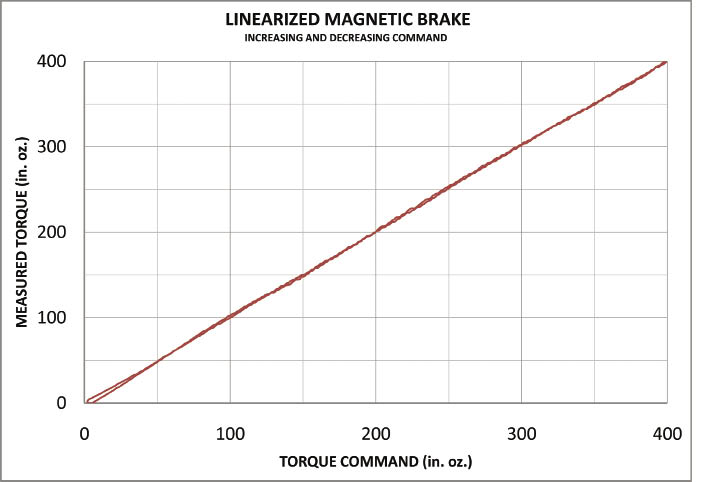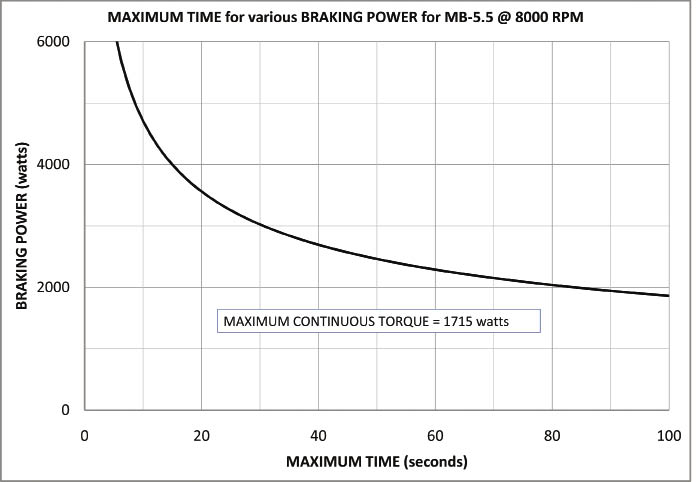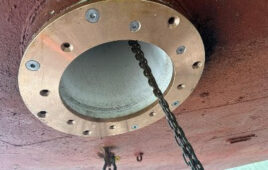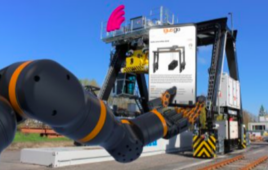By Jim M. Bogdanowicz/Senior Systems Engineer
Manfred G. Michelson/President
Markus G. Michelson/Vice President
Magnetic Brake Systems, a division of Technical Film Systems, Inc.
Frustrated by some of the drawbacks of hysteresis brakes, we designed a new type of magnetic brake.
Contact-less magnetic brakes are ideal for applications requiring precise repeatability, no wear with time, and zero dust emission. The most common contact-less brakes available commercially are hysteresis brakes. However, for our film transport equipment, we have been struggling with the drawbacks of hysteresis brakes for more than thirty years. Thus, we started a new division of TFS called Magnetic Brakes Systems (MBS) and developed a new magnetic brake without the drawbacks of hysteresis brakes. This magnetic brake is a combination of a hysteresis brake and an eddy-current brake, figure 1.
The five drawbacks we found with hysteresis brakes are:
- They have hysteresis. As the input current to the hysteresis brake is increased by a certain amount, the output torque of the brake will increase; but when the input current is decreased by the same amount the torque will not decrease by the same amount, figure 2.
- The torque output is not linear with the input current, figure 2.
- All conventional hysteresis brakes have cogging. If a current is applied to a brake and the brake is brought to a full stop and the current is then turned off, the brake will have a certain amount of residual magnetism. The residual magnetism shows itself as torque pulses as the brake rotor rotates from pole to pole. This residual torque may be as high as 25% of the brakes maximum torque.
- Although often stated incorrectly, the torque output of conventional hysteresis brakes is not independent of speed. The output torque of a conventional hysteresis brake increases with rotor speed and is the result of eddy current braking.
- Conventional hysteresis brakes have relatively low power dissipation compared to the newly designed magnetic brakes.
- All of these drawbacks above are virtually eliminated in the MBS magnetic brakes.
Eliminating hysteresis and non-linearity
We eliminated hysteresis and the non-linearity with an embedded microcontroller. The torque-versus-current characteristic of the brakes is measured with a MBS Model 20 dynamometer. The dynamometer consists of a variable speed motor, a torque arm, and a load cell.
A PC controls the speed and magnetic brake current. The PC runs the brakes through all possible torque and speed ranges for both increasing and decreasing currents in approximately 1% increments. The result is that up to 100,000 current–torque points are measured and then stored in the embedded microcontroller for various speeds up to the maximum allowable speed for that particular brake.
When it is required to send a predetermined torque, the microcontroller interpolates the data points in its memory to determine what current will produce the required torque. The microcontroller continuously senses whether the input signal is increasing or decreasing and thus is able to pick the proper points on the graph (figure 2). Figure 3 shows an actual measurement of torque output as a function of an increasing input signal and a decreasing input signal.

FIGURE 3: Oscilloscope recording showing the torque output for an increasing and decreasing signal. The sawtooth appearance of the graphs is due to the quantization of the input signal.
Eliminating the cogging effect
The cogging effect, or residual magnetism, encountered in hysteresis brakes is often the main drawback and reason for not using one for a particular application. There are multiple hysteresis brakes on the market that eliminate the cogging effect, but none of them seem to eliminate the cogging without any motion of the drag ring.
Based mainly on empirical work and trial and error, we were able to come up with a design that eliminates the residual magnetism by applying a decaying sine wave to the brake coil. The first few cycles of the decaying sine wave will often cause the drag ring to rotate a small amount. This slight movement causes a reduction in de-magnetization. Consequently, the drag ring is locked into position by a voice coil magnet mounted on a leaf spring. This design eliminates all sliding moving components. The entire demagnetization takes less than 500 milliseconds. The remnant magnetic cogging torque is on the order of the ball bearing friction.
Taking advantage of the Eddy current effect
Eddy currents are created in magnetic materials when the material is passed through a magnetic field. Since energy is dissipated in terms of heat, the eddy currents can be used to cause braking in addition to the hysteresis braking. A characteristic of eddy current brakes is that the braking torque is proportional to the speed and is zero at zero speed. This may cause potential problems when the brakes need to be used for constant torque purposes, but is an asset when one needs to have additional braking at higher speeds. Since an embedded microcontroller is already used as an interface to eliminate cogging, hysteresis, and nonlinearities, it is a simple matter to correct the torque as a function of the angular velocity within the applicable speed range of the brake.
To measure the angular velocity of the magnetic brake, one or several small magnets are installed on the periphery of the impeller. A hall-effect sensor detects the time interval between the pulses produced by the magnet(s). It is a trivial matter for the microcontroller to then compute the angular velocity of the brake and correct the torque such that it is independent of speed within the allowable speed range of the brake.
Increasing the power dissipation
There are two areas of interest in the power dissipation of magnetic brakes; the transient and the steady state power dissipation.
All of the braking energy dissipated by the brake is turned to heat in the drag ring. The heat is generated by both hysteresis and eddy current effects. It should be remembered that the eddy current effect is zero at zero speed. Eddy current effects increase with the drag ring thickness–the difference of the drag ring outer diameter and inner diameter divided by two; the MBS magnetic brakes have a substantially thicker drag ring than most commercially available magnetic brakes.
The transient, or short term, heat dissipation is largely a function of the thermal inertia of the drag ring. In many applications, such as decelerating a 3-ft diameter roll of film to a quick stop, very short term high-energy dissipation is essential. As an example, the Magnetic Brake Systems model MB-5.50 with a 4.56-in. drag ring diameter can dissipate 4,700 W, or about 6 hp, for a period of 10 sec, figure 4.
Steady state, or continuous, power dissipation is largely aided by the impeller and ventilation holes shown in figure 1. The impeller, or centrifugal blower, creates a slightly negative pressure at the ventilation holes relative to the ambient pressure. This negative pressure forces airflow through the ventilation holes. The pressure produced by the impeller varies with the square of the angular velocity of the impeller. This phenomenon fortunately works in our favor. It should be remembered that power is a product of torque and angular velocity. Thus, when the brake is running at very low speeds there is essentially no heat being generated; at maximum speed the power is at maximum and the airflow is at the maximum.
In order to obtain maximum power dissipation from a brake it should, either through gears or belts, be geared up to run at maximum allowable speed.
Once you have a microcontroller in the system …
There are many industrial applications where items such as film, wire or cloth are unrolled from a supply roll and the radius of the roll gets smaller, as the element is unwound. Magnetic brakes are great at holding constant torque, but what about holding constant tension with a variable radius roll?
The unwinding tension is a function of the brake torque and the radius. The changes in radius are measured simply by sensing the timing pulses from a second roller in the system, which has a constant radius. The tension is now a function of the ratio of the time between pulses from the fixed radius roll divided by the time from the variable radius roll. As explained above the microprocessor adjusts the brake signal to obtain a constant tension.
Similarly, the tension on the roll being wound can be measured and adjusted.
Magnetic Brake Systems Div.,
Technical Film Systems, Inc.
www.magbrakesystems.com
Filed Under: Brakes • clutches, MECHANICAL POWER TRANSMISSION









Thanks for all usefull informations. But still I have problem with select the rotor material. Currently I have a disc of Alluminium T6 6061. But I have doubt to use of iron disc instead of that to get better breaking torque. If you don’t mind please guide me in this case.
Warm Regards
I am looking for a magnetic brake device that can be coupled around a vehicle prop shaft. The aim is not a main brake but to assist in braking the vehicle on steep downhill descents for sustained periods of around 15 minutes. The current vehicle engine do not have an engine brake and there are no space to fit a retarder. The application will be for a truck with a loaded weight of 11,5 tons. The required downhill speed must be limited to maximum 7km/h. Do you have any suggestions